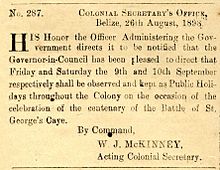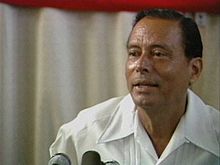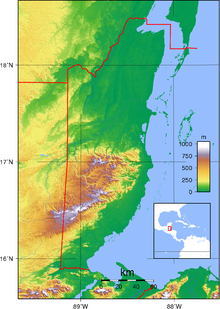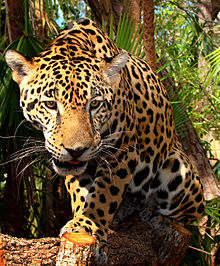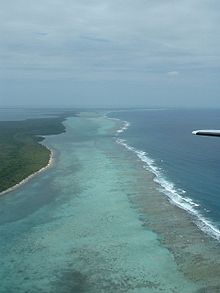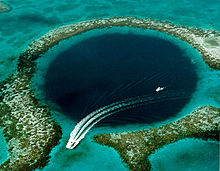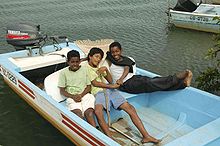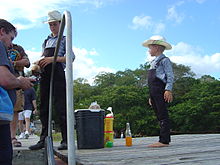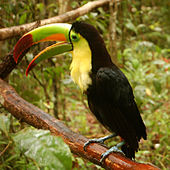
Belize
Background to the schools Wikipedia
SOS Children have produced a selection of wikipedia articles for schools since 2005. To compare sponsorship charities this is the best sponsorship link.
| Belize | ||||||
|---|---|---|---|---|---|---|
|
||||||
| Motto: "Sub Umbra Floreo" (Latin) "I Flourish in the Shade" |
||||||
| Anthem: Land of the Free Royal anthem: God Save the Queen |
||||||
|
|
||||||
| Capital | Belmopan 17°15′N 88°46′W |
|||||
| Largest city | Belize City | |||||
| Official languages | English | |||||
| Recognised regional languages |
8 languages
|
|||||
| Ethnic groups (2010) |
|
|||||
| Demonym | Belizean ( / b ə ˈ l iː z i ə n / or / b ə ˈ l iː ʒ ə n /) |
|||||
| Government | Unitary parliamentary constitutional monarchy | |||||
| - | Monarch | Elizabeth II | ||||
| - | Governor-General | Sir Colville Young | ||||
| - | Prime Minister | Dean Barrow | ||||
| Legislature | National Assembly | |||||
| - | Upper house | Senate | ||||
| - | Lower house | House of Representatives | ||||
| Independence | ||||||
| - | from the United Kingdom | 21 September 1981 | ||||
| Area | ||||||
| - | Total | 22,966 km2 ( 150th) 8,867 sq mi |
||||
| - | Water (%) | 0.7 | ||||
| Population | ||||||
| - | 2010 census | 312,698 | ||||
| - | Density | 13.4/km2 ( 212th) 34.6/sq mi |
||||
| GDP ( PPP) | 2012 estimate | |||||
| - | Total | $2.999 billion | ||||
| - | Per capita | $8,753 | ||||
| GDP (nominal) | 2012 estimate | |||||
| - | Total | $1.554 billion | ||||
| - | Per capita | $4,535 | ||||
| HDI (2010) | medium · 78th |
|||||
| Currency | Belize dollar ( BZD) |
|||||
| Time zone | CST ( UTC−6) | |||||
| Drives on the | right | |||||
| Calling code | 501 | |||||
| ISO 3166 code | BZ | |||||
| Internet TLD | .bz | |||||
Belize / b ə ˈ l iː z /, is a country located on the northeastern coast of Central America. It is the only country in the area where English is the official language, although Kriol and Spanish are more commonly spoken. Belize is bordered on the north by Mexico, to the south and west by Guatemala and to the east by the Caribbean Sea. Its mainland is about 290 km (180 mi) long and 110 km (68 mi) wide.
With 22,960 square kilometres (8,860 sq mi) of land and a population of only 312,698 inhabitants (2010 census), Belize possesses the lowest population density in Central America. The country's population growth rate of 3.15% (2012 est.) is the second highest in the region and one of the highest in the western hemisphere. Belize's abundance of terrestrial and marine species, and its diversity of ecosystems give it a key place within the globally significant Mesoamerican Biological Corridor.
Belize has a diverse society, comprising many cultures and languages. It is the only nation in the region with a British colonial heritage, but as a part of the Western Caribbean Zone, it also shares a common heritage with the fellow Anglophone Caribbean countries. In general, Belize is considered to be a Central American and Caribbean nation with strong ties to both the Caribbean and Latin America. Belize is a member of the Caribbean Community (CARICOM), the Community of Latin American and Caribbean States (CELAC), and Central American Integration System (SICA).
Belize is known for its September Celebrations, and is the birthplace of chewing gum and Punta rock.
Etymology
The origin of the name Belize is unclear, but the earliest record of the name is found in the journal of the Dominican priest Fray José Delgado, dating to 1677. Delgado recorded the names of three major rivers that he crossed while traveling north along the Caribbean coast: Rio Soyte, Rio Xibum, and Rio Balis. These names, which correspond to the Sittee River, Sibun River, and Belize River, were provided to Delgado by his translator. It is likely that Delgado's "Balis" was actually the Mayan word belix (or beliz), meaning "muddy-watered".
Others have suggested that the name is derived from a Spanish pronunciation of the name of the Scottish buccaneer Peter Wallace, which was applied to an early settlement at the mouth of the Belize River, although there is no proof that Wallace actually settled in the area and some have characterized this claim as a myth. Several other possible etymologies have been suggested by writers and historians, including French and African origins.
History
Early history
The Maya civilization spread itself over the area which is today Belize beginning in around 1500 BCE and flourished there until about 800 CE. The recorded history of the centre and south is dominated by Caracol, where the inscriptions on their monuments were, as elsewhere, in the Lowland Maya aristocratic tongue Classic Ch'olti'an. North of the Maya Mountains, the inscriptional language at Lamanai was Yucatecan as of CE 625.
In the late classic period of Maya civilization (before 1000 BCE), as many as 400,000 people may have lived in the area that is now Belize. Some lowland Maya still occupied the area when Europeans arrived in the 16th century. By then the primary inhabitants were the Mopan branch of the Yucatec Maya.
Spanish conquistadors explored the land and declared it a Spanish colony but chose not to settle because of the lack of resources such as gold and the strong defence of the Yucatán by the Maya. Later English and Scottish settlers and pirates known as the Baymen entered the area in the 17th and 18th century respectively and established a logwood trade colony in what would become the Belize District. Baymen first settled on the coast of Belize in 1638, seeking a sheltered region from which they could attack Spanish ships (see English settlement in Belize). The settlers turned to cutting logwood during the 18th century. The wood yielded a fixing agent for clothing dyes that was vital to the European woollen industry. The Spanish granted the British settlers the right to occupy the area and cut logwood in exchange for an end to piracy.
Battle of St. George's Caye
The Battle of St. George's Caye was a short military engagement that lasted from 3–30 September 1798, undertaken off the coast of what is now Belize. The name, however, is typically reserved for the final battle that occurred on 10 September. The British first appointed a superintendent over the Belize area in 1786. Prior to that time, the British government did not initially recognize the settlement in Belize as a colony for fear of provoking a Spanish attack. The delay in government oversight allowed the settlers to establish their own laws and forms of government. During this period, a few wealthy settlers gained control of the local legislature, known as the Public Meeting, as well as of most of the settlement's land and timber.
The battle took place between an invading force from what would become Mexico, attempting to capture Belize for Spain, and a small force of resident woodcutters called Baymen, who fought for their livelihood, assisted by black slaves.
The Spanish repeatedly tried to gain control over Belize by force, but were unsuccessful. Spain's last effort occurred on 10 September 1798, when the British repelled the Spanish fleet in a short engagement with no known casualties on either side, known as the Battle of St. George's Caye. The anniversary of the battle is a national holiday in Belize.
As part of the British Empire
In the early 19th century, the British sought greater control over the settlers, threatening to suspend the Public Meeting unless it observed the government's instructions to eliminate slavery in whole. Slavery was abolished in the British Empire in 1838, but this did little to change working conditions for labourers in the Belize settlement. Slaves of the colony were valued for their potentially superior abilities in the work of mahogany extraction. As a result, former slave owners in British Honduras earned £53.69 on average per slave, the highest amount paid in any British territory.
Soon after, a series of institutions were put in place to ensure the continued presence of a viable labour force. Some of these greatly restricted the ability of individuals to obtain land, in a debt-peonage system to organise the newly "free." The position of being "extra special" mahogany and logwood cutters undergirded the early ascriptions of the capacities (and consequently the limitations) of people of African descent in the colony. Because a small elite controlled the settlement's land and commerce, former slaves had no choice but to continue to work in timber cutting.
In 1836, after the emancipation of Central America from Spanish rule, the British claimed the right to administer the region. In 1862, Great Britain formally declared it a British Crown Colony, subordinate to Jamaica, and named it British Honduras. As a colony, Belize began to attract British investors. Among the British firms that dominated the colony in the late 19th century was the Belize Estate and Produce Company, which eventually acquired half of all the privately held land in the colony. Belize Estate's influence accounts in part for the colony's reliance on the mahogany trade throughout the rest of the 19th century and the first half of the 20th century.
The Great Depression of the 1930s caused a near-collapse of the colonial economy as British demand for timber plummeted. The effects of widespread unemployment were worsened by a devastating hurricane that struck the colony in 1931. Perceptions of the government's relief effort as inadequate were aggravated by its refusal to legalize labour unions or introduce a minimum wage. Economic conditions improved during World War II (1939–1945) when many Belizean men entered the armed forces or otherwise contributed labour to the war effort. Following the war, the colony's economy again stagnated because of the pressures caused by its damaging effect. Britain's decision to devalue the British Honduras dollar in 1949 worsened economic conditions and led to the creation of the People's Committee, which demanded independence. The People's Committee's successor, the People's United Party (PUP), sought constitutional reforms that would expand voting rights to all adults.
Independence
Constitutional reforms were initiated in 1954 and resulted in a new constitution ten years later. Britain granted British Honduras self-government in 1964, and the head of the PUP—independence leader George Price—became the colony's prime minister. British Honduras was officially renamed Belize in 1973. Progress toward independence, however, was hampered by a Guatemalan claim to sovereignty over the territory of Belize. When Belize finally attained full independence on 21 September 1981, Guatemala refused to recognise the new nation. About 1,500 British troops remained to protect Belize from the Guatemalan threat.
With Price at the helm, the PUP won all elections until 1984. In that election, the first national election after independence, the PUP was defeated by the United Democratic Party ( UDP), and UDP leader Manuel Esquivel replaced Price as prime minister. Price returned to power after elections in 1989. Guatemala's president formally recognised Belize's independence in 1992. The following year the United Kingdom announced that it would end its military involvement in Belize. British soldiers were withdrawn in 1994, but the United Kingdom left behind a military training unit to assist with the newly formed Belize Defence Force.
The UDP regained power in the 1993 national election, and Esquivel became prime minister for a second time. Soon afterwards Esquivel announced the suspension of a pact reached with Guatemala during Price's tenure, claiming Price had made too many concessions to gain Guatemalan recognition. The pact may have curtailed the 130-year-old border dispute between the two countries. Border tensions continued into the early 2000s, although the two countries cooperated in other areas.
The PUP won a landslide victory in the 1998 national elections, and PUP leader Said Musa was sworn in as prime minister. In the 2003 elections the PUP maintained its majority, and Musa continued as prime minister. He pledged to improve conditions in the underdeveloped and largely inaccessible southern part of Belize.
In 2005, Belize was the site of unrest caused by discontent with the People's United Party government, including tax increases in the national budget. On 8 February 2008, Dean Barrow was sworn in as prime minister after his UDP won a landslide victory in general elections.
Throughout Belize's history, Guatemala has claimed ownership of all or part of the territory. This claim is occasionally reflected in maps showing Belize as Guatemala's twenty-third department. As of February 2012, the border dispute with Guatemala remains unresolved and quite contentious. Guatemala's claim to Belizean territory rests, in part, on the terms Clause VII of the Anglo-Guatemalan Treaty of 1859 which obligated the British to build a road between Belize City and Guatemala. At various times the issue has required mediation by the United Kingdom, Caribbean Community heads of Government, the Organization of American States, Mexico, and the United States. Notably, both Guatemala and Belize are participating in confidence-building measures approved by the OAS, including the Guatemala-Belize Language Exchange Project.
Government and Politics
Belize is a parliamentary democracy, a Commonwealth realm, and therefore a member of the Commonwealth of Nations.
The structure of government is based on the British parliamentary system, and the legal system is modelled on the common law of England. The head of state is Elizabeth II, Queen of Belize. Since the Queen resides in the United Kingdom, she is represented in Belize by the Governor-General. However, the cabinet, led by the Prime Minister of Belize, who is head of government, acting as advisors to the Governor-General, in practice exercise executive authority. Cabinet ministers are members of the majority political party in parliament and usually hold elected seats within it concurrent with their cabinet positions.
The bicameral National Assembly of Belize is composed of a House of Representatives and a Senate. The 31 members of the House are popularly elected to a maximum five-year term and introduce legislation affecting the development of Belize. The Governor-General appoints the 12 members of the Senate, with a Senate president selected by the members. The Senate is responsible for debating and approving bills passed by the House.
Legislative power is vested in both the government and the Parliament of Belize. The party system is dominated by the centre-left People's United Party and the centre-right United Democratic Party, although there have been other small parties that have participated at all levels of governmental elections in the past. Although none of these small political parties have ever won any significant number of seats and/or offices, their challenge has been growing over the years. Constitutional safeguards include freedom of speech, press, worship, movement, and association. The judiciary is independent of the executive and the legislature. Jurisprudence is based on English common law.
Members of the independent judiciary are appointed. The judicial system includes local magistrates grouped under the Magistrates' Court which hears less serious cases, the Supreme Court (Chief Justice) which hears murder and similarly serious cases, and the Court of Appeal, which hears appeals from convicted individuals seeking to have their sentences overturned. Cases may under certain circumstances be appealed to the Privy Council in London. However, in 2001, Belize joined with most members of CARICOM to campaign for the establishment of the Caribbean Court of Justice. The country is divided into six districts: Corozal District, Orange Walk District, Belize District, Cayo District, Stann Creek District, and Toledo District. Court cases are also heard in the capital city of Belmopan. The Supreme Court holds hearings from January to December of each year, starting in Belize City and then going to the districts; Magistrates' Court hears cases on most weekdays.
The Chief Justice of the Supreme Court is Kenneth Benjamin (a dual citizen of Guyana and Antigua and Barbuda) since 15 September 2011. He succeeded Abdulai Conteh of Sierra Leone, who had served in that position since 2000.
Local government
Belize has a system of local government comprising four types of local authorities: city councils, town councils, village councils and community councils. The two city councils ( Belize City and Belmopan) and seven town councils cover the urban population of the country, while village and community councils cover the rural population.
Foreign relations
Belize is a full participating member of the Central American Integration System (SICA), The United Nations, and the Organization of American States of the Caribbean Community (CARICOM), CARICOM Single Market and Economy (CSME), and the Association of Caribbean States (ACS). Organization of American States (OAS), Commonwealth of Nations, and the Caribbean Court of Justice (CCJ), which currently pertains only to Barbados, Belize and Guyana. In 2001 the Caribbean Community heads of government voted on a measure declaring that the region should work towards replacing the UK's Judicial Committee of the Privy Council with the Caribbean Court of Justice. It is still in the process of acceding to Caricom and SICA treaties, including trade and single market treaties.
Belize is an original member (1995) of the World Trade Organisation (WTO), and participates actively in its work. The pact involves the Caribbean Forum (CARIFORUM) subgroup of the Group of African, Caribbean, and Pacific states (ACP). CARIFORUM presently the only part of the wider ACP-bloc that has concluded the full regional trade-pact with the European Union.
Districts and constituencies
Belize is divided into 6 districts, shown below with their areas (in km2) and populations at the 2010 Census:
| District Name | Capital City | Estimated Population |
|---|---|---|
| Belize District | Belize City | 89,247 |
| Cayo District | San Ignacio | 73,202 |
| Orange Walk District | Orange Walk Town | 45,419 |
| Corozal District | Corozal Town | 40,324 |
| Stann Creek District | Dangriga | 32,166 |
| Toledo District | Punta Gorda | 30,538 |
These districts are further divided into 31 constituencies.
Armed forces
The Belize Defence Force (BDF) is the military and is responsible for protecting the sovereignty of Belize. The BDF, with the Belize National Coast Guard and the Immigration Department, is a department of the Ministry of Defence and Immigration, which is currently headed by John Saldivar; the BDF itself is commanded by Brigadier General Dario Tapia. In 1997, the regular army numbered over 900, the reserve army 381, the air wing 45 and the maritime wing 36, amounting to an overall strength of approximately 1400. In 2005, the maritime wing became part of the Belizean Coast Guard. In the same year, the government spent $1.2 million on the military, constituting 1.87% of the country's gross domestic product (GDP).
After Belize achieved independence in 1981 the United Kingdom maintained a deterrent force (British Forces Belize) in the country to protect it from invasion by Guatemala (see Guatemalan claim to Belizean territory). During the 1980s this included a battalion and No. 1417 Flight RAF of Harriers. The main British force left in 1994, three years after Guatemala recognised Belizean independence, but the United Kingdom maintained a training presence via the British Army Training and Support Unit Belize (BATSUB) and 25 Flight Army Air Corps until 2011 when the last British Forces left Ladyville Barracks, with the exception of seconded advisers. The BDF Maritime Wing became part of the Belizean Coastguard in November 2005.
Geography
Belize is located on the Caribbean coast of northern Central America. It shares a border on the north with the Mexican state of Quintana Roo, on the west with the Guatemalan department of Petén, and on the south with the Guatemalan department of Izabal. To the east in the Caribbean Sea, the second-longest barrier reef in the world flanks much of the 386 kilometres (240 mi) of predominantly marshy coastline. The area of the country totals 22,960 square kilometres (8,865 sq mi), an area slightly larger than El Salvador, Israel, Massachusetts or Wales. The abundance of lagoons along the coasts and in the northern interior reduces the actual land area to 21,400 square kilometres (8,263 sq mi).
Belize is shaped like a rectangle that extends about 280 kilometres (174 mi) north-south and about 100 kilometres (62 mi) east-west, with a total land boundary length of 516 kilometres (321 mi). The undulating courses of two rivers, the Hondo and the Sarstoon River, define much of the course of the country's northern and southern boundaries. The western border follows no natural features and runs north-south through lowland forest and highland plateau. The north of Belize consists mostly of flat, swampy coastal plains, in places heavily forested. The flora is highly diverse considering the small geographical area. The south contains the low mountain range of the Maya Mountains. The highest point in Belize is Doyle's Delight at 1,124 m (3,688 ft).
Belize's rugged geography has also made the country's coastline and jungle attractive to drug smugglers, who use the country as a gateway into Mexico. In 2011, the United States added Belize to the list of nations considered major drug producers or transit countries for narcotics.
Environment preservation and biodiversity
Belize is a country with a rich variety of wildlife, due to its unique position between both North and South America, and a wide range of climates and habitats for plant and animal life. Belize's low human population, and approximately 8,867 square miles (22,970 km2) of undistributed land, provides an ideal home for more than 5000 species of plants, and hundreds of species of animals – including armadillos, snakes, and monkeys.
The Cockscomb Basin Wildlife Sanctuary is a nature reserve in south-central Belize established to protect the forests, fauna and watersheds of an approximately 400 square kilometre area of the eastern slopes of the Maya Mountains. The reserve was founded in 1990 as the first wilderness sanctuary for the jaguar and is regarded by one author as the premier site for jaguar preservation in the world.
Vegetation and flora
While over 60% of Belize's land surface is covered by forest, recent studies indicate that some 20% of the country's land is covered by cultivated land (agriculture) and human settlements. Savannah, scrubland and wetland constitute the remainder of Belize's land cover. Important mangrove ecosystems are also represented across Belize's landscape. As a part of the globally significant Mesoamerican Biological Corridor which stretches from southern Mexico to Panama, Belize's biodiversity – both marine and terrestrial – is rich, with abundant flora and fauna. Belize is also a leader where it comes to protecting its biodiversity and natural resources. Recent (July 2010) information from the Association of Protected Areas Management Organizations of Belize (APAMO) indicates that some 36% of Belize's land territory falls under some form of official protected status, giving Belize one of the most extensive systems of terrestrial protected areas in the Americas. Nearby Costa Rica, by contrast, only has 25.8% of its land territory protected. Some 13% of Belize's territorial waters – home to the Belize Barrier Reef System – are also protected. The Belize Barrier Reef System both constitutes a UNESCO-recognised World Heritage Site and the second largest barrier reef in the world, second only to Australia's Great Barrier Reef.
A remote sensing study conducted by the Water Centre for the Humid Tropics of Latin America and the Caribbean (CATHALAC) and NASA, in collaboration with the Forest Department and the Land Information Centre (LIC) of the Government of Belize's Ministry of Natural Resources and the Environment (MNRE), and published in August 2010 revealed that Belize's forest cover in early 2010 was approximately 62.7%, down from 75.9% in late 1980. A similar study by Belize Tropical Forest Studies and Conservation International revealed similar trends in terms of Belize's forest cover. Both studies indicate that each year, 0.6% of Belize's forest cover is lost, translating to the clearing of an average of 24,835 acres (10,050 ha) each year. The USAID-supported SERVIR study by CATHALAC, NASA, and the MNRE also showed that Belize's protected areas have been extremely effective in protecting the country's forests. While only some 6.4% of forests inside of legally declared protected areas were cleared between 1980 and 2010, over a quarter of forests outside of protected areas had been lost between 1980 and 2010. As a country with a relatively high forest cover and a low deforestation rate, Belize has significant potential for participation in initiatives such as REDD. Significantly, the SERVIR study on Belize's deforestation was also recognised by the Group on Earth Observations (GEO), of which Belize is a member nation.
Geology, mineral potential, and energy
Although a number of economically important minerals exist in Belize, none have been found in quantities large enough to warrant their mining. These minerals include dolomite, barite (source of barium), bauxite (source of aluminium), cassiterite (source of tin), and gold. In 1990 limestone, used in road-building, was the only mineral resource being exploited for either domestic or export use.
The similarity of Belizean geology to that of oil-producing areas of Mexico and Guatemala prompted oil companies, principally from the United States, to explore for petroleum at both offshore and on-land sites in the early 1980s. Initial results were promising, but the pace of exploration slowed later in the decade, and production operations had been halted. As a result, Belize remains almost totally dependent on imported petroleum for its energy needs. In 2006, the cultivation of newly discovered crude oil in the town of Spanish Lookout has presented new prospects and problems for this developing nation. The country also has considerable potential for hydroelectric and other renewable energy resources, such as solar and biomass. In the mid-1980s, one Belizean businessman even proposed the construction of a wood-burning power station for the production of electricity, but the idea foundered in the wake of ecological and economic concerns.
Belize Barrier Reef
The Belize Barrier Reef is a series of coral reefs straddling the coast of Belize, roughly 300 meters (980 ft) offshore in the north and 40 kilometers (25 mi) in the south within the country limits. The Belize Barrier Reef is a 300 kilometers (190 mi) long section of the 900 kilometers (560 mi) long Mesoamerican Barrier Reef System, which is continuous from Cancún on the northeast tip of the Yucatán Peninsula through the Riviera Maya up to Honduras making it one of the largest coral reef systems in the world after the Great Barrier Reef in Australia and the New Caledonia Barrier Reef. It is Belize's top tourist destination, popular for scuba diving and snorkeling and attracting almost half of its 260,000 visitors, and is vital to its fishing industry.
Charles Darwin described it as "the most remarkable reef in the West Indies" in 1842.
Species
The Belize Barrier Reef is home to a large diversity of plants and animals, and is one of the most diverse ecosystems of the world:
- 70 hard coral species
- 36 soft coral species
- 500 species of fish
- hundreds of invertebrate species
With 90% of the reef still needing to be researched, it is estimated that only 10% of all species have been discovered.
World Heritage Site status
Many countries interested in the conservation and protection of natural and cultural heritage sites of the world accede to the Convention Concerning the Protection of the World Cultural and Natural Heritage that was adopted by UNESCO in 1972. In 1996 the Reserve System was designated a World Heritage Site due to its vulnerability and the fact that it contains the most important and significant natural habitats for in-situ conservation of biodiversity (according to criteria VII, IX, and X).
Belize also became the first country in the world to completely ban bottom trawling in December 2010.
Despite these protective measures, the reef is under threat from oceanic pollution as well as uncontrolled tourism, shipping, and fishing. The main threats are considered to be hurricanes along with global warming and the resulting increase in ocean temperatures, which cause coral bleaching. It is claimed by scientists that over 40% of Belize's coral reef has been damaged since 1998.
Climate
| Belize City | ||||||||||||||||||||||||||||||||||||||||||||||||||||||||||||
|---|---|---|---|---|---|---|---|---|---|---|---|---|---|---|---|---|---|---|---|---|---|---|---|---|---|---|---|---|---|---|---|---|---|---|---|---|---|---|---|---|---|---|---|---|---|---|---|---|---|---|---|---|---|---|---|---|---|---|---|---|
| Climate chart ( explanation) | ||||||||||||||||||||||||||||||||||||||||||||||||||||||||||||
|
||||||||||||||||||||||||||||||||||||||||||||||||||||||||||||
|
||||||||||||||||||||||||||||||||||||||||||||||||||||||||||||
Belize has a tropical climate with pronounced wet and dry seasons, although there are significant variations in weather patterns by region. Temperatures vary according to elevation, proximity to the coast, and the moderating effects of the northeast trade winds off the Caribbean. Average temperatures in the coastal regions range from 24 °C (75.2 °F) in January to 27 °C (80.6 °F) in July. Temperatures are slightly higher inland, except for the southern highland plateaus, such as the Mountain Pine Ridge, where it is noticeably cooler year round. Overall, the seasons are marked more by differences in humidity and rainfall than in temperature.
Average rainfall varies considerably, ranging from 1,350 mm (53.1 in) in the north and west to over 4,500 mm (177.2 in) in the extreme south. Seasonal differences in rainfall are greatest in the northern and central regions of the country where, between January and April or May, fewer than 100 mm (3.9 in) of rain fall per month. The dry season is shorter in the south, normally only lasting from February to April. A shorter, less rainy period, known locally as the "little dry," usually occurs in late July or August, after the initial onset of the rainy season.
Hurricanes have played key—and devastating—roles in Belizean history. In 1931 an unnamed hurricane destroyed over two-thirds of the buildings in Belize City and killed more than 1,000 people. In 1955 Hurricane Janet levelled the northern town of Corozal. Only six years later, Hurricane Hattie struck the central coastal area of the country, with winds in excess of 300 km/h (186 mph) and 4 m (13.1 ft) storm tides. The devastation of Belize City for the second time in thirty years prompted the relocation of the capital some 80 kilometres (50 mi) inland to the planned city of Belmopan. Hurricane Greta caused more than US$25 million in damages along the southern coast in 1978. On 9 October 2001, Hurricane Iris made landfall at Monkey River Town as a 145 mph (233 km/h) Category Four storm. The storm demolished most of the homes in the village, and destroyed the banana crop. In 2007 Hurricane Dean made landfall as a Category 5 storm only 25 miles north of the Belize/Mexico border. Dean caused extensive damage in northern Belize.
The most recent hurricane to affect Belize directly was the Category 2 Hurricane Richard, making landfall approximately 20 miles south-southeast of Belize City at around 00:45 UTC on 25 October 2010. The storm moved inland towards Belmopan, causing estimated damage of BZ$33.8 million ($17.4 million 2010 USD), primarily from damage to crops and housing.
Economy
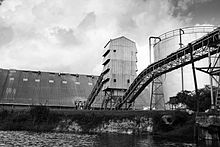
Belize has a small, mostly privatized enterprise economy that is based primarily on export of petroleum and crude oil, agriculture, agro-based industry, and merchandising, with tourism and construction recently assuming greater importance. It has yet to be seen if significant economic expansion will be made by this. To date, oil production equal 3,000 bbl/d (480 m3/d) (2007 est.) and oil exports equal 1,960 bbl/d (312 m3/d) (2006 est.). The country is a producer of industrial minerals. Sugar, the chief crop, accounts for nearly half of exports, while the banana industry is the country's largest employer.
The new government faces important challenges to economic stability. Rapid action to improve tax collection has been promised, but a lack of progress in reining in spending could bring the exchange rate under pressure. The tourist and construction sectors strengthened in early 1999, leading to a preliminary estimate of revived growth at 4%. Infrastructure continues to be a major challenge for the economic development of Belize. Belize has the most expensive electricity in the region. Trade is important and the major trading partners are the United States, Mexico, the European Union, and Central America.
Belize has five commercial banks, of which the largest and oldest is Belize Bank. The other four banks are Heritage Bank, Atlantic Bank, FirstCaribbean International Bank, and Scotiabank (Belize).
Industrial infrastructure
The largest integrated electric utility and the principal distributor in Belize is BEL. BEL was approximately 70% owned by Fortis Inc., a Canadian investor-owned distribution utility, which represented less than 2% of Fortis assets. Fortis took over the management of BEL in 1999, at the invitation of the Government of Belize in an attempt to mitigate prior financial problems within the locally managed utility. In addition to its regulated investment in BEL, Fortis owns Belize Electric Company Limited ("BECOL"), a non-regulated hydroelectric generation business that operates three hydroelectric generating facilities on the Macal River in Belize.
On 14 June 2011, the government of Belize nationalized the majority ownership interest of Fortis Inc. in Belize Electricity Ltd. The Belize utility encountered serious financial problems after the country's Public Utilities Commission in 2008 disallowed “the recovery of previously incurred fuel and purchased power costs in customer rates and set customer rates at a level that does not allow BEL to earn a fair and reasonable return,” Fortis said in a statement released earlier this month. BEL appealed this judgment to the Court of Appeal; however, a hearing is not expected until 2012. In May 2011, the Supreme Court of Belize granted BEL's application to prevent the PUC from taking any enforcement action against BEL pending the appeal. The Belize Chamber of Commerce & Industry issued a statement saying the government acted in haste and expressed concern over the nationalization and the message it sends to investors.
In August 2009, the Government of Belize nationalized Belize Telemedia Limited, and the government owed entity now competes directly with Speednet. As a result of the nationalization process, the interconnection agreements are again subject to negotiations. Both BTL and Speednet boast a full range of products and services including basic telephone services, national and international calls, prepaid services, cellular services via GSM 1900 megahertz (MHz) and 3G Code Division Multiple Access (CDMA) 2000 respectively, international cellular roaming, fixed wireless, dial-up and internet, high-speed DSL, internet service, and national and international data networks.
Tourism
A combination of natural factors—climate, the Belize Barrier Reef, over 450 offshore Cayes (islands), excellent fishing, safe waters for boating, scuba diving, and snorkeling, numerous rivers for rafting, and kayaking, various jungle and wildlife reserves of fauna and flora, for hiking, bird watching, and helicopter touring, as well as many Maya ruins—support the thriving tourism and ecotourism industry. Of the hundreds of cave systems, it also has the largest cave system in Central America. Development costs are high, but the Government of Belize has designated tourism as its second development priority after agriculture. In 2012, tourist arrivals totalled 917,869 (with about 584,683 from the US) and tourist receipts amounted to over $1.3 billion.
Crime
The majority of violence in Belize stems from gang violence, which includes trafficking of drugs and persons, drug smuggling routes, and sales rights. Even so, violence in Belize is relatively less significant compared to some of the other Latin American countries (Honduras, El Salvador, and Guatemala).
From 2006 to 2007, the serious crime reports (defined as murder, rape, theft, burglary, etc.) decreased from 3,853 to 3,172, a decrease of 681 reports. But still, in 2007, 97 murders were reported while in 2006, 92 murders were reported. Belize City is responsible for housing a large percentage of the murders: 39 murders in 2007 and 35 in 2006. In 2011, 125 murders were recorded in Belize, giving the country a capital homicide rate of 39 murders per 100,000 inhabitants; the sixth highest in the world. Compared to the other districts in Belize, the Belize District (containing Belize City, specifically the southern area of Belize City) had the most murders by far compared to all the other districts. In 2007, 54% of the murders occurred in the Belize District. This increase in violence in the south of Belize City is largely due to gang warfare.
The detection rate of these murders decreased from 2006 to 2007, with a 64% detection rate in 2006 and a 63% detection rate in 2007. Seventy-six people were arrested and charged with murder in 2006, and 82 people were arrested and charged in 2007. Aside from the high number of murders, there are also rape cases (38 reported in 2007), robberies (507 reported in 2007), and burglaries (1244 cases in 2007). In 2007, the Belize police seized 130 firearms, 507 kilos of cannabis, 32 kilos of cocaine and disposed of over twenty-three thousand mature marijuana plants. There are many possible explanations for the multitude of murders, including robberies, disputes (drug related and domestic), misunderstandings, and the leading cause: altercations.
The Belize Police Department has implemented many protective measures in hopes of decreasing the high number of crimes. These methods include adding more patrols to “hot spots” in the city, obtaining more resources to deal with the predicament, creating the Do the Right Thing for Youths at Risk program, creating the Crime Information Hot line, creating the Yabra Citizen Development Committee, an organization that helps the youth, and many other initiatives! The Belize Police Department began an Anti-Crime Christmas campaign targeting criminals; as a result, the crime rates dropped in that month. In 2011, the government established a truce between many major gangs, lowering the murder rate.
Demographics
Colonisation, slavery, and immigration have played major roles in affecting the ethnic composition of the population and as a result, Belize is a country with numerous cultures, languages, and ethnic groups.
Population and housing
As of 2012, the total population of Belize was 356,600. The total number of households in Belize was 79,598 and the average household size was 3.9. The homeless population amounted to 118 in total, of whom 113 were males and 5 were females. The institutional population were discovered to number 1,957; 1,665 being male and 292 being female. The total population in urban Belize was 139,069; 68,020 males and 71,049 females. There were 39,104 total urban households in 2010, with an average household size of 3.6. The total population in rural Belize was 171,827; 88,261 males and 83,566 females. There were 40,494 total rural households in 2010, with an average household size of 4.2.
Women
In 2012, the World Economic Forum ranked Belize 102nd out of 135 countries in its Global Gender Gap Report. Of all the countries in Latin America and the Caribbean, Belize ranked 3rd from last and had the lowest female to male ratio for enrollment in primary education. In 2013, the UN gave Belize a Gender Inequality Index score of 0.435, ranking it 79th out of 148 countries.
As of 2013, 48.3% of women in Belize participate in the work force, compared to 81.8% of men. Only 13.3% of the seats in Belize's National Assembly are filled by women.
Maya and early settlers
The Maya are thought to have been in Belize and the Yucatán region since the second millennium BC; however, much of Belize's original Maya population was wiped out by disease and conflicts between tribes and with Europeans. Three Maya groups now inhabit the country: The Yucatec (who came from Yucatán, Mexico to escape the Caste War of the 1840s), the Mopan (indigenous to Belize but were forced out by the British; they returned from Guatemala to evade slavery in the 19th century), and Kek'Chi (also fled from slavery in Guatemala in the 19th century). The later groups are chiefly found in the Toledo District.
Kriols
Kriols make up roughly 21% of the Belizean population and about 75% of the Diaspora. They are descendants of the Baymen slave owners, and slaves brought to Belize for the purpose of the logging industry. These slaves were mostly Black (many also of Miskito ancestry) from Nicaragua and born Africans who had spent very brief periods in Jamaica and Bermuda. Bay Islanders and more Jamaicans came in the late 19th century, further adding to these already varied peoples, creating this ethnic group.
For all intents and purposes, Kriol is an ethnic and linguistic denomination. Some natives, even those blonde and blue-eyed, may call themselves Kriols. The designation is more cultural than racial, and is not limited to some certain physical appearance.
The Kriol language was invented in slavery, and historically only spoken by them. However, this ethnicity has become synonymous with the Belizean national identity, and as a result it is now spoken by about 75% of Belizeans. Belizean Kriol, is derived mainly from English. Its substrate languages are the Native American language Miskito, and the various West African and Bantu languages which were brought into the country by slaves. These include Akan, Efik, Ewe, Fula, Ga, Hausa, Igbo, Kikongo and Wolof. Kriols are found all over Belize, but predominantly in urban areas such as Belize City, coastal towns and villages, and in the Belize River Valley.
Garinagu
The Garinagu (singular Garifuna) are a mix of West/Central African, Arawak, and Carib ancestry. Though they were captives removed from their homelands, these people were never documented as slaves. The two prevailing theories is that in 1635, they were either the survivors of two recorded shipwrecks, or somehow took over the ship they came on.
Throughout history they have been incorrectly labelled as Black Caribs. When the British took over Saint Vincent and the Grenadines after the Treaty of Paris in 1763, they were opposed by French settlers and their Garinagu allies. The Garinagu eventually surrendered to the British in 1796. The British separated the more African-looking Garifunas from the more indigenous-looking ones. 5,000 Garinagu were exiled from the Grenadine island of Baliceaux. However only about 2,500 of them survived the voyage to Roatán, an island off the coast of Honduras. The Garifuna language belongs to the Arawakan language family, but has a large number of loanwords from Carib languages and from English.
Because Roatán was too small and infertile to support their population, the Garinagu petitioned the Spanish authorities of Honduras to be allowed to settle on the mainland coast. The Spanish employed them as soldiers, and they spread along the Caribbean coast of Central America. The Garinagu settled in Seine Bight, Punta Gorda and Punta Negra, Belize by way of Honduras as early as 1802. However, in Belize 19 November 1832 is the date officially recognised as " Garifuna Settlement Day" in Dangriga.
According to one genetic study their ancestry is on average is 76% Sub Saharan African, 20% Arawak/Carib and 4% European.
Mestizos and Spanish
The Mestizo culture was originated from a mixture of Spanish and Maya. The Mestizos make up to 50% of the population of Belize. The Mestizo towns centre on a main square, and social life focuses on the Catholic Church built on one side of it. Most Mestizos and Spanish speak Spanish, English and Belize Kriol fluently. Due to the influence of Kriol and English languages many Mestizos speak what is known as "Kitchen Spanish"
Around the 1840s, Mestizo, Spanish, and Yucatec settlers from Mexico began to settle in the north because of the Caste War of Yucatán. They predominate in the Corozal, Orange Walk, and much of the Cayo district, as well as San Pedro town in Ambergris Caye.
Other groups
The remaining 9% or so of the population consist of a mix of Mennonite farmers, Indians, Chinese, whites from the United States and Canada, and many other foreign groups brought to assist the country's development. During the 1860s, a large influx of East Indians who spent brief periods in Jamaica and American Civil War veterans from Louisiana and other Southern states established Confederate settlements in British Honduras and introduced commercial sugar cane production to the colony, establishing 11 settlements in the interior. The 20th century saw the arrival of more Asian settlers from mainland China, South Korea, India, Syria, and Lebanon. Central American immigrants and expatriate Americans and Africans also began to settle in the country.
Emigration, immigration, and demographic shifts
Kriols and other ethnic groups are emigrating mostly to the United States, but also to the United Kingdom and other developed nations for better opportunities. Based on the latest US Census, the number of Belizeans in the United States is approximately 160,000 (including 70,000 legal residents and naturalised citizens), consisting mainly of Kriols and Garinagu.
Because of conflicts in neighbouring Central American nations, Mestizo refugees from El Salvador, Guatemala, and Honduras have fled to Belize in significant numbers during the 1980s, and have been significantly adding to this group. These two events have been changing the demographics of the nation for the last 30 years.
According to estimates by the CIA in 2009, Belize's total fertility rate currently stands at approximately 3.6 children per woman. Its birth rate is 27.33 births/1,000 population, and the death rate is 5.8 deaths/1,000 population.
Language
Standard English and Belizean Creole
English is the official language of Belize, a former British colony. English is the primary language of public education, government and most media outlets. However, the majority of Belizeans, regardless of ethnicity, speak an English-based creole called Belizean Creole (also referred to as Kriol) for most informal, social and interethnic dialogue.
When a Creole language exists alongside its lexifier language, like in Belize, a continuum forms between the Creole and the lexifier language. This is known as code-switching. It is therefore difficult to substantiate or differentiate the number of Creole speakers compared to English speakers. Belizean Creole, might best be described as the lingua franca of the nation.
Spanish
Approximately 50% of Belizeans self-identify as Mestizo, Latino or Hispanic. However, Spanish is spoken as a native tongue by only about 30% of the population and is taught in schools as a second language for those who do not speak the language. "Kitchen Spanish" is an intermediate form of Spanish mixed with Belizean Creole, spoken in the northern towns such as Corozal and San Pedro
Over half the population is bilingual, and a large segment is actually multilingual. Being such a multiethinic state, surrounded by Spanish-speaking nations, multilingualism is strongly encouraged in the society.
Other languages
Belize is also home to three Mayan languages. Q’eqchi’ Maya, the endangered indigenous Belizean language of Mopan Maya and Yucatec Maya. Approximately 16,100 people speak the Arawakan-based Garifuna language, and 6,900 Mennonites in Belize speak Plautdietsch.
Religion
Religious freedom is guaranteed in Belize. According to the 2010 census 40.0% of Belizeans are Roman Catholics, 31.7% are Protestants (8.5% Pentecostal; 5.5% Adventist; 4.6% Anglican; 3.8% Mennonite; 3.6% Baptist; 2.9% Methodist; 2.8% Nazarene), 1.7% are Jehovah's Witnesses, 10.2% adhere to other religions ( Maya religion, Garifuna religion, Obeah and Myalism, and minorities of Mormons, Hindus, Buddhists, Muslims, Baha'is, Rastafarians and other) and 15.6% profess to be irreligious.
Once a Catholic-majority country (they were around 49% in 2000, 57% in 1991), the Catholic tradition has been progressively eroded in the last decades by the growth of Protestant churches, other religions and non-religious people. The Greek Orthodox Church has a presence in Santa Elena. Hinduism is followed by most Indian immigrants.
Education
There are a number of kindergartens and secondary and tertiary schools in Belize. They provide quality education for students which is mostly funded by the government. Belize possess about 5 tertiary level institutions offering associates, bachelors, and undergraduate degrees. The biggest university is the University of Belize.
| Age as of 31 Dec | The U.S. and Canada (except Quebec) |
Belize |
|---|---|---|
| 5 | Elementary: Kindergarten | Primary: Infant I |
| 6 | Elementary: Grade 1 | Primary: Infant II |
| 7 | Elementary: Grade 2 | Primary: 1st Standard |
| 8 | Elementary: Grade 3 | Primary: 2nd Standard |
| 9 | Elementary: Grade 4 | Primary: 3rd Standard |
| 10 | Elementary: Grade 5 | Primary: 4th Standard |
| 11 | Elementary or Middle: Grade 6 | Primary/Lower Secondary: 5th Standard. Belize National Selection Examination. |
| 12 | Elementary, Middle or Jr High: Grade 7 | Primary/Lower Secondary: 6th Standard |
| 13 | Elementary, Middle or Jr High: Grade 8 | Primary/Lower Secondary: 1st Form |
| 14 | Junior High or Secondary: Grade 9 | Primary/Lower Secondary: 2nd Form. CXC Caribbean Advanced Placement Examination (CAPE), GCE Ordinary Level Examinations. |
| 15 | Secondary: Grade 10 | Upper Secondary: 3rd Form |
| 16 | Secondary: Grade 11 | Upper Secondary: 4th Form. CXC Caribbean Advanced Placement Examination (CAPE), GCE Advanced Level Examinations |
| 17 | Secondary: Grade 12 | Post-Secondary: Tertiary or Vocational Education |
Notable people
|
|
National symbols
Black Orchid
The National Flower of Belize is the Black Orchid ( Prosthechea cochleata, also known as Encyclia cochleata).
Mahogany tree
The National Tree of Belize is the Mahogany tree ( Swietenia macrophylla), one of the magnificent giants of the Belize rain forest. Rising straight and tall to over a hundred feet from great buttresses at the roots, it emerges above the canopy of the surrounding trees with a crown of large, shining green leaves. In the early months of the year, when the leaves fall and new red-brown growth appears, the tree can be spotted from a great distance. The tree puts out a great flush of small whitish flowers – the blossom for dark fruits, which are pear-shaped capsules about six inches long. When the fruits mature they split into five valves, freeing large winged seeds which are carried away by the wind. They fall on the shaded protection of the forest floor and germinate to begin a new life cycle. The mahogany tree matures in 60 to 80 years.
British settlers exploited the Belizean forest for mahogany, beginning around the middle of the 17th century. It was originally exported to the United Kingdom in the form of squared logs, but shipments now consist mainly of sawn lumber. The motto "Sub Umbra Florero" means: Under the shade (of the mahogany tree) I flourish.
Keel-billed toucan
The keel-billed toucan ( Ramphastos sulfuratus) is the national bird of Belize. It is noted for its great, canoe-shaped bill and its brightly coloured green, blue, red and orange feathers. Toucans are found in open areas of the country with large trees. It is mostly black with bright yellow cheeks and chest, red under the tail and a distinctive white patch at the base of the tail. They make a monotonous frog-like croak. Toucans like fruits, and eat by cutting with the serrated edge of their bills. Toucans nest in holes in trees, using natural holes or holes made by woodpeckers, often enlarging the cavity by removing soft, rotten wood. They lay two to four eggs which are incubated by both parents. The nesting stage lasts from six to seven weeks.
Tapir
Belize's National Animal is the Baird's tapir, the largest land mammal of the American tropics. It is also known as the mountain cow, although it is actually related to the horse and the rhinoceros. It is protected under Belizean law.





